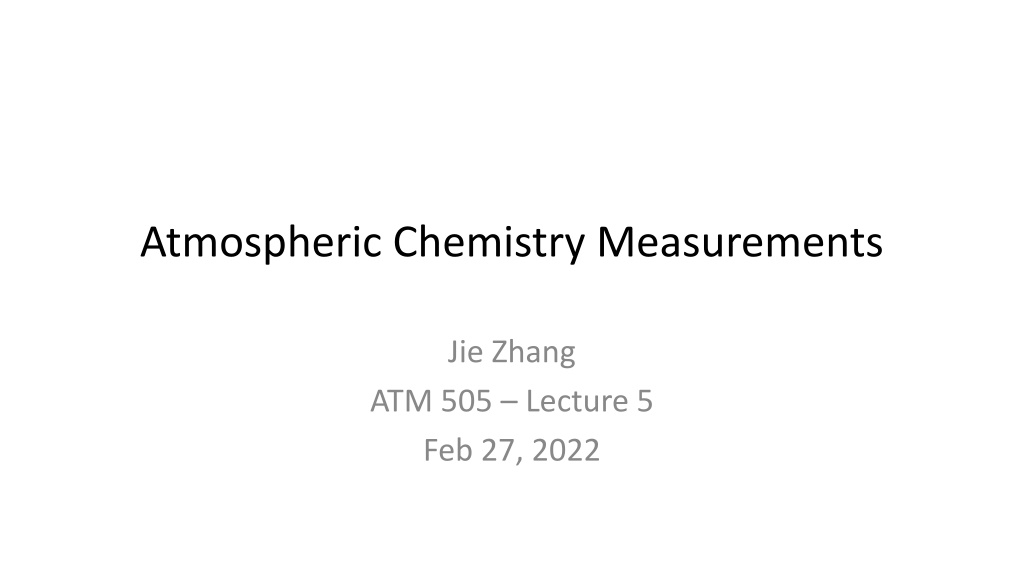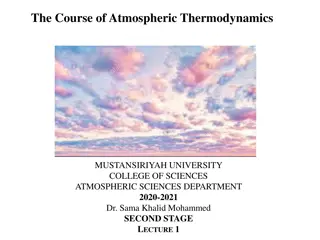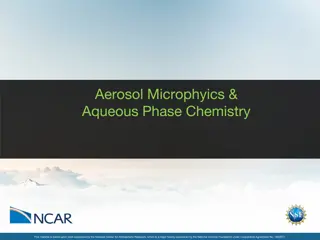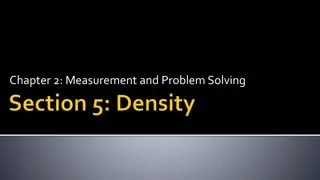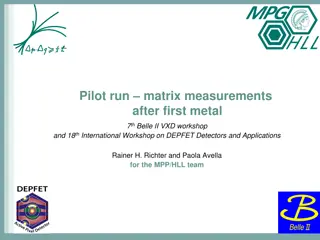Understanding Atmospheric Chemistry Measurements and Methods
Explore the various types of atmospheric chemistry measurements, including research vs. monitoring, gas phase species, satellite vs. in situ observations, and spectroscopy and chromatography methods. Discover how researchers and regulatory bodies use different techniques to study and monitor air quality parameters essential for understanding atmospheric composition and pollution levels.
Download Presentation

Please find below an Image/Link to download the presentation.
The content on the website is provided AS IS for your information and personal use only. It may not be sold, licensed, or shared on other websites without obtaining consent from the author. Download presentation by click this link. If you encounter any issues during the download, it is possible that the publisher has removed the file from their server.
E N D
Presentation Transcript
Atmospheric Chemistry Measurements Jie Zhang ATM 505 Lecture 5 Feb 27, 2022
References and Acknowledgements Books: Aerosol Measurement: Principles, Techniques, and Applications. Baron and Willeke, Wiley Interscience (2001) Aerosol Technology: Properties, Behavior, and Measurement of Airborne Particles, 2nd Edition, Hinds (1999) Paper: A review of atmospheric aerosol measurements, McMurry, Atmospheric Environment (2000) Lectures: Steven Massie and Jim Smith Berko Sierau (for Joel Thorton) 2
Kinds of Measurements: Research vs Monitoring Research Measurements Address scientific question or problem University scientists, private foundations, national labs Limited duration (a few weeks to a few months, typically) Goal is to write and publish peer-reviewed papers Often use state-of-the-art or research methods and measure species that are challenging to capture Monitoring Done to establish compliance with air pollution regulations Mainly states, localities, and indigenous nations Long Term often many decades Well established methods and commercial instruments Limited number of species measured 3
Measurements of Gas Phase Species Gaseous Criteria Pollutants (things that are specifically regulated by the Clean Air Act) - monitoring Greenhouse Gases Volatile Organic Carbon species (VOCs) Reactive and short lived species (research measurements) 4
Satellite vs in situ Satellite measurements play an increasingly important role Measure column density (molecules cm-2) and not concentration (molecules cm-3) Only have good data for a limited number of species (~10) In situ measurements Collect samples and measure true concentrations (mostly) Hundreds (thousands?) of sites Hundreds of species measured 5
Methods - Spectroscopy and Chromatography Spectroscopy takes advantage of the interaction of light and matter. Chemical substances (atoms and molecules) interact with specific wavelengths of light in ways that allow them to be fingerprinted Absorption: used for O3, CO, CO2, and more Fluorescence: used for SO2, NO2, Cl, OH, and more Chemiluminescence: mainly used for NO (and NO2) 6
Chromatography Gas Chromatography relies on the slight differences in structure and reactivity of a class of similar species to separate the species in a long, very narrow column coated on the inside with a mildly reactive coating material. Separated compoundsexit the column in time order and are detected by one of numerous methods Detection methods include mass spectrometry, flame ionization, photoionization, electron capture, and numerous others 7
Matching Species with Methods Criteria Pollutants: in situ O3 and CO (Absorption); SO2 (pulsed fluorescence), and NO/NO2 (chemiluminescence) VOCs: Gas chromatography on whole air samples collected in canisters and transported to analysis labs GHGs: in situ infrared absorption and sample collection with GC; increasingly sensitive laser based IR absorption Reactive species: often research, one of a kind, and state-of- the-art instruments, laser based, mass spec based 8
Types of Aerosol Measurements Aerosol Mass Concentration (regulated quantity NAAQS) Filters (gravimetric) Continuous (various) Physical Properties Number Concentration Size Distribution Shape Optical properties scattering and absorption (index of refraction) Chemical Composition Filters (various) Continuous (various) 14
Mass Concentration Units are micrograms per cubic meter - g/m3. The current US National Ambient Air Quality Standard (NAAQS) regulates PM2.5 measured on a teflon filter. Previous NAAQS regulated first Total Suspended Particles (TSP), then PM10 The gravimetric method (a Federal Reference Method or FRM) is described in great detail, but the result cannot be considered a true scientific measurement ! (This is due to the complexity of the challenge, and not incompetence.) Probably the single largest complication is due to aerosol volatility. In spite of this measurement shortcoming, this data is consistent, reliable, and actionable in a regulatory sense. 15
The FRM in brief Filters are specified, inspected and individually stamped with a number. Filters are conditioned and pre-weighed, put into cassettes then sent to sampling locations. Filter cassettes are loaded into samplers that have carefully audited size cutpoint and flow characteristics. They are sampled for 24 hours at the specified flow rate. After removal from the sampler, filters are kept cool before and during shipment back to the analysis lab (and upon arrival). At the lab, filters are conditioned as before and weighed. Mass comes from the difference between the two weighings: flow, temperature and pressure determine the sample volume. Recall - g/m3. 16
Continuous Mass Measurements TEOM Tapered Element Oscillating Microbalance. Uses the relationship between oscillation frequency and mass to directly measure mass changes. -attenuation (where is an electron) uses measurement of the reduction in intensity of particles passing through a particle laden filter tape. The relationship between attenuation and particle concentration is reasonably independent of the chemical composition of the atmosphere. Optical methods use the physical properties of scattering or extinction (more later). 17
Measurements of Physical Properties Particle number concentration Particle Size Distribution (PSD) Particle Shape (not covered here not routinely or easily measured) Optical Properties (A subject unto itself we will only scratch the surface) 20
Particle Number Concentration Aerosol Electrometer aerosols in the atmosphere have a steady-state charge distribution, that is a mixture of positive, negative, and (mostly) neutral charges. If this distribution is known and can be described and it often is and can be then a sensitive electrometer can measure total aerosol concentration. Condensation Particle Counter (CPC) easiest and most reliable method. 21
Optical Particle Counter (OPC): ~ 100 nm to 5 m Size limits defined by Mie scattering, and Mie scattering theory is used to interpret integrated scattered intensity. Disadvantages: too sensitive to small changes in refractive index scattering angle particle size particle shape Advantages: Can detect small particles (but not the smallest) Non-intrusive Instantaneous and continuous information
Condensation Particle Counter Saturate an aerosol with water or alcohol vapor Cool by adiabatic expansion or flow through a cold tube (can also heat in some cases, the temperature gradient is the key) Nuclei will grow to ~ 10 m (particles this size will scatter visible light with good efficiency) Every condensable nuclei grows to a (small 10-12 m) droplet Measure the number of droplets with an e.g. single particle optical counter 23
Condensation Particle Counter (CPC): ~1.5 nm to 0.5 m ambient aerosol size range Condensation Particle Counters (CPCs) detects particles by exposing them to a region that is supersaturated with vapor (usually butanol), thus allowing particles to grow to a size that can be optically detected. Counting efficiency curve: TSI model 3010 Response time: TSI model 3010
Particle Size Distribution Impactor relies on inertial characteristics of particles (i.e., larger, more massive particles have greater inertia) Differential Mobility Analyzer creates steady-state charge distribution and balance mass and charge as aerosols flow through an electric field 25
Two things are changing with each stage: Diameter of nozzle Distance from nozzle to impactor plate To decrease the cut-off diameter from stage to stage is achieved by a) decreasing the nozzle diameters (increase in particle/air velocity) b) and/or decreasing the number of nozzles c) and/or decreasing the pressure (increase in slip correction). 27
DMA - Differential Mobility Analyzer A charged particle will be pushed in the direction of VTE by the electric field E between the two plates. Hinds 28
Aerosol Chemical Composition National networks include CSN (Chemical Speciation Network) mostly urban locations; and IMPROVE mostly rural & remote locations Like with Mass Concentration, the routine network measurements are 24 hour samples collected on filters and analyzed post-sampling in the laboratory. Many networks collect three different filters: 1. A Teflon filter which is analyzed for total mass and elements using XRF (X- Ray Fluorescence) 2. A Nylon filter (preceeded by gas denuders) which is digested and analyzed for major ionic species (i.e., sulfate, nitrate, ammonium, etc.) 3. A pre-baked quartz filter which is analyzed for total carbonaceous material and the empirically defined Elemental Carbon (EC) and Organic Carbon (OC) fractions. 30
Continuous Chemical Composition Mass Spectrometry (many types, very active research field) next slides Particle- Into Liquid-Sampling (PILS) can be couple with Ion Chromatography, Total Organic Carbon detection, etc. A variety of analyzers or systems for one or more chemical fraction, like carbon, sulfate, or nitrate. 31
Aerosol Mass Spectrometer (AMS) For an excellent review of this and other instruments that measure aerosol composition using mass spectrometry see: http://cires.colorado.edu/~jjose/Papers/2010- 09_IAC_Aerosol_MS_Tutorial.pdf Aerodyne Research, Incorporated
Field observations Lab Lab Canagaratna et al., Mass Spec Rev, v26, P185-222,2007. 33
AMS mass spectrum from ambient aerosol Since the AMS uses electron impact ionization and high temperature, species are modified as they are desorbed and ionized. Luckily, marker species and co-varying peaks can be found that uniquely identify compound classes. A high-resolution Time-Of-Flight Mass Spectrometer (TOFMS) has been developed for use with the AMS, thus allowing for elemental analyses such as C:O. In the TOFMS, an E field accelerates ions of different mass to the same kinetic energy m v2. Larger mass ions travel at slower v than lighter ions. For each ion, measure the travel time between two laser beams, get v, and then m.
